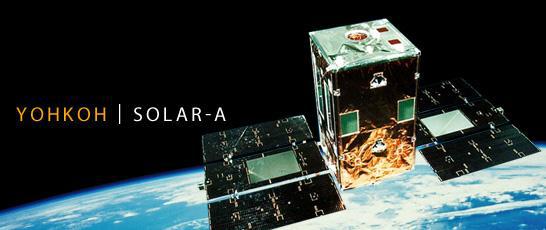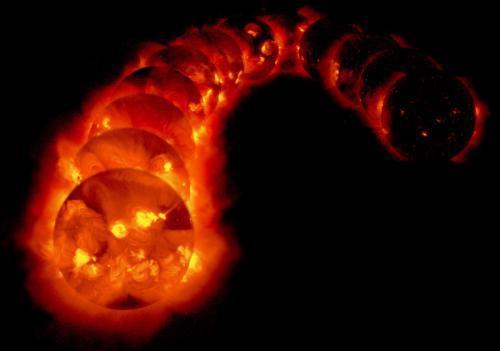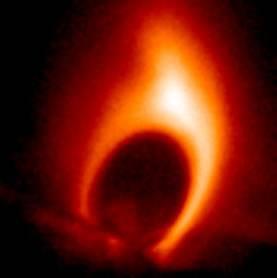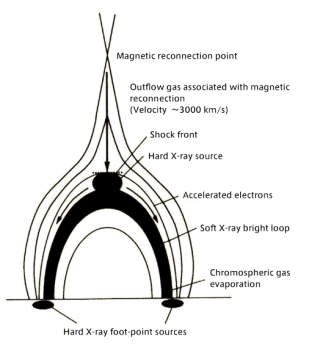Hinotori and Yohkoh
Two solar observation satellites have been launched from Japan, Hinotori in 1981 and Yohkoh in 1991. These satellites were equipped with instruments which observed the Sun mainly through X-rays, and achieved various results.

©ISAS/JAXA

©ISAS/JAXA
Seeing Flares through X-rays
In solar flares, super-hot plasmas are created. When the temperature exceeds 1,000,000 K, objects emit X-rays, so if you observe the flares with X-rays, you can directly investigate the characteristics of high temperature plasma in solar flares.
Leading the world in X-ray Observations
Two solar observation satellites led the world for solar observations in the X-ray and gamma ray regions, opening up new disciplines.
Yohkoh's Soft X-ray Telescope continuously observed activity cycle variations of the solar corona for over 10 years.

Solar Corona Activity Cycle Variations taken in Soft X-rays.
Covering the period from just after the launch of Yohkoh (bottom left) to solar minimum (in 1995, far right). (©JAXA/NASA)
Yohkoh's Scientific Achievements
Solar flares occur at the so-called active regions where sunspots exist. In other words, solar flares occur where strong magnetic fields with complicated structures exist. From this, we knew that the magnetic fields are the energy sources for flares before Yohkoh's launch. But, we didn't know what kind of mechanism converts that energy and releases it as heat and particle acceleration. One of the hypotheses considered as a mechanism for releasing the energy was magnetic reconnection. Magnetic reconnection is a physical process in which antiparallel magnetic lines of force come close to each other and reconnect, converting the energy of the magnetic field into thermal and kinetic energies in a short time. Yohkoh proved observationally that solar flares are triggered by magnetic reconnections. The figure below is a solar flare captured by Yohkoh. It turned out that the tip of a coronal loop shining in soft X-rays (which are long wavelength X-rays) was tapered (known as a cusp structure). This matches the prediction of the magnetic reconnection theory for solar flares. From these Yohkoh observations, the scenario of magnetic reconnection in solar flares was established almost beyond doubt. But, we didn't have the magnetic field information, so we couldn't figure out what triggered the magnetic reconnection. Therefore, the next important task was getting magnetic field information.


A flare captured by Yohkoh (left) and a schematic figure of solar flares via magnetic reconnection (right). (©ISAS/JAXA)
Solar Mysteries Left for Hinode
In order to search for the trigger causing magnetic reconnection, the magnetic field information is necessary. Also, in studies to determine the details of magnetic reconnection, it is necessary to observe plasma motions. This is to capture plasma flows resulting from magnetic reconnection which transforms the energy of the magnetic field into heat and acceleration of the plasma.
Moreover, besides the mechanism by which flare occurs, there are many unknown mysteries of the Sun. One of the typical issues is the "coronal heating problem." The surface temperature of the Sun (photosphere) is 6,000 K, while the atmosphere above it, known as the corona, is 1,000,000 K. How does the corona get heated?
To solve these mysteries, we need an X-ray telescope with high spatial resolution, which can observe more detailed phenomena than Yohkoh could. It is also important to have a visible light telescope that can capture detailed phenomena from outer space, unaffected by the fluctuations of the Earth's atmosphere.
Therefore, we developed Hinode, equipped with these observational instruments and entrusted it with further surveys to solve the mysteries of the Sun.
Regarding the use of images and movies on the page concerned, please visit the page here. The credits of images and movies on this page are “NAOJ/JAXA” unless explicitly stated to the contrary. Regarding images and movies on this page the credits of which are “NAOJ/JAXA”, "NAOJ/JAXA/MSU", or “NAOJ, JAXA, NASA/MSFC”, terms of use for Copyrighted Works owned by NAOJ can be applied. In using the images and movies, the credits should be given.
